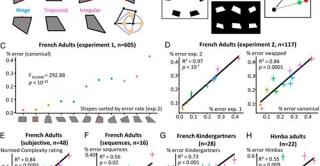
Determining the cognitive differences between human and nonhuman primates is a central goal of cognitive neuroscience. We show that intuitions of geometry are present in humans but absent in baboons. A simple intruder task in which subjects must find which of six geometric shapes is different reveals an effect of geometric regularity in all human groups regardless of age, education, and culture, yet this effect is absent in baboons. Models of the ventral visual pathway for object recognition predict baboons’ performance, but a symbolic model is needed to account for human performance. Our results underline the human propensity for symbolic abstraction, even in an elementary shape perception task, and provide a challenge for neural network models of human shape perception.